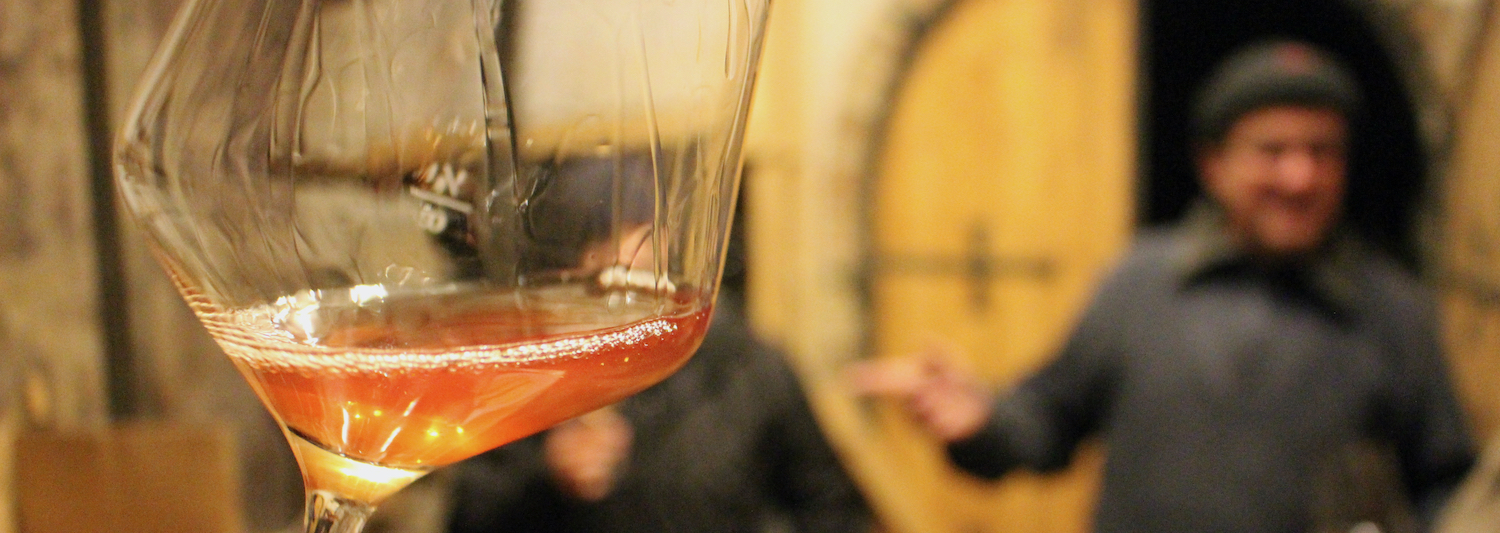

Andert, Neusiedlersee, Austria

At a Glance
http://www.andert-wein.at/
Neusiedlersee
Continental (hot summers & cold winters)
loess and loam
120m
Flat cropland and trees
Pinot Gris, Pinot Blanc, Neuburger, Zweigelt, Cabernet Sauvigon, Sankt Laurent
4.5 hectares
BioDynamic (Demeter Certified)
Animal manure
Neusiedlersee
Continental (hot summers & cold winters)
loess and loam
120m
Flat cropland and trees
Pinot Gris, Pinot Blanc, Neuburger, Zweigelt, Cabernet Sauvigon, Sankt Laurent
4.5 hectares
BioDynamic (Demeter Certified)
Animal manure

Erich and Michael Andert in the cellar
The People
Just a few hundred meters from the Hungarian border and just East of lake Neusiedl, lies the small town of Pamhagen. Brothers Erich and Michael Andert have been Demeter Certified since 2003 and their whole property is buzzing with life. Nearly everything on the property seems edible. Walking around the vineyard you can find large glass jars of fermenting vegetables or open a random door by a shed and find meats smoking and curing. Herbs of all sorts (Michael is a certified herb educator) hang from the rafters and there are countless tinctures littering the cellar floor. Erich and Michael are also consummate hosts. The dinner salad from exclusively from their cover crops, local pumpkin seed oil for dressing, and every following dish comes with simple preparation done to perfection.
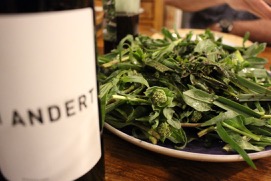
Andert wine with a salad of cover crops
There’s an attention to detail, not overworked or made too complicated, and always with the best ingredients. The joy of sharing a table with them is the same as sharing a bottle of wine. Upon our last visit they were gearing up to host children from the Vienna International School to promote Demeter certified products, harvest and cook with the children, and ultimately raise awareness and money for charity. This mindset speaks to everything that they do. As Michael told us, “We go inside the life.”

Andert wine with a salad of cover crops
There’s an attention to detail, not overworked or made too complicated, and always with the best ingredients. The joy of sharing a table with them is the same as sharing a bottle of wine. Upon our last visit they were gearing up to host children from the Vienna International School to promote Demeter certified products, harvest and cook with the children, and ultimately raise awareness and money for charity. This mindset speaks to everything that they do. As Michael told us, “We go inside the life.”

In the vineyard
Vineyards
Right out in the middle of their 4.5 hectares is giant chicken, goose, and duck coop. Just a few meters from there, there’s an area devoted to sheep. All are used for bolster the biodiversity of the property, supply fertilizer, and of course add to future dinner menus. Horns from years of biodynamic preparations are fixed along the fence line and hides of wild boars hang nearby to deter the deer. Depending on the year, the most potent spraying they have to do is horsetail tea.

Michael Andert in the cellar
Winemaking
All wines are hand harvested, sometimes destemmed, open vat fermentation, always native yeast, no temperature control, little to no racking, and everything is aged in oak barrels. Wines are bottled without filtration and total SO2 is about 15-20ppm. No other additions are made. Inside their traditional underground stone cellar, there is no electricity. The wines are free to evolve and develop without interference.

Erich Andert showing the winter bottle storage

Erich Andert showing the winter bottle storage

White Wine , Organic
Grüner Veltliner;
11%
1 g/l
4.8 g/l
Grüner Veltliner;
11%
1 g/l
4.8 g/l
This wine holds a special place in the family. Planted in 1976, the name comes from a dialect that pulls from their Hungarian heritage and essentially translates to their family farm. 2015 was the first vintage in the current style. The grapes are stomped by foot, 10 days of skin contact, no racking, and aged in 400L oak barrels. No additions of any kind. This wine feels ionically charged. It manages to carry the skin contact, not lose sight of the grape, and carry the signature of their land all in one.

White Wine , Organic
Grüner Veltliner;
11.3%
1 g/l
6.5 g/l
Grüner Veltliner;
11.3%
1 g/l
6.5 g/l
This wine holds a special place in the family. Planted in 1976, the name comes from a dialect that pulls from their Hungarian heritage and essentially translates to their family farm. 2015 was the first vintage in the current style. The grapes are stomped by foot, 10 days of skin contact, no racking, and aged in 400L oak barrels. No additions of any kind. This wine feels ionically charged. It manages to carry the skin contact, not lose sight of the grape, and carry the signature of their land all in one.

Red Wine , Organic
Zweigelt;
9.6%
1.6 g/l
5.8 g/l
Zweigelt;
9.6%
1.6 g/l
5.8 g/l
When you first arrive at the Andert Farm, you’ll likely be given a glass of Traubensaft (fresh grape juice) to help get you grounded on where you are. The Blauer Zweiglet is likely one of the next things to be offered. Hand picked, then a mixture of destemmed and whole cluster are fermented in open vats for about 10 days. It’s then barreled down to 225L, 500L, and 600L used oak barrels and usually bottled in the summer. Unfiltered and a little SO2 at bottling (20-30ppm total). This is a perfect introduction to the bright (under 10% alcohol), herbal and energetic style of the estate.
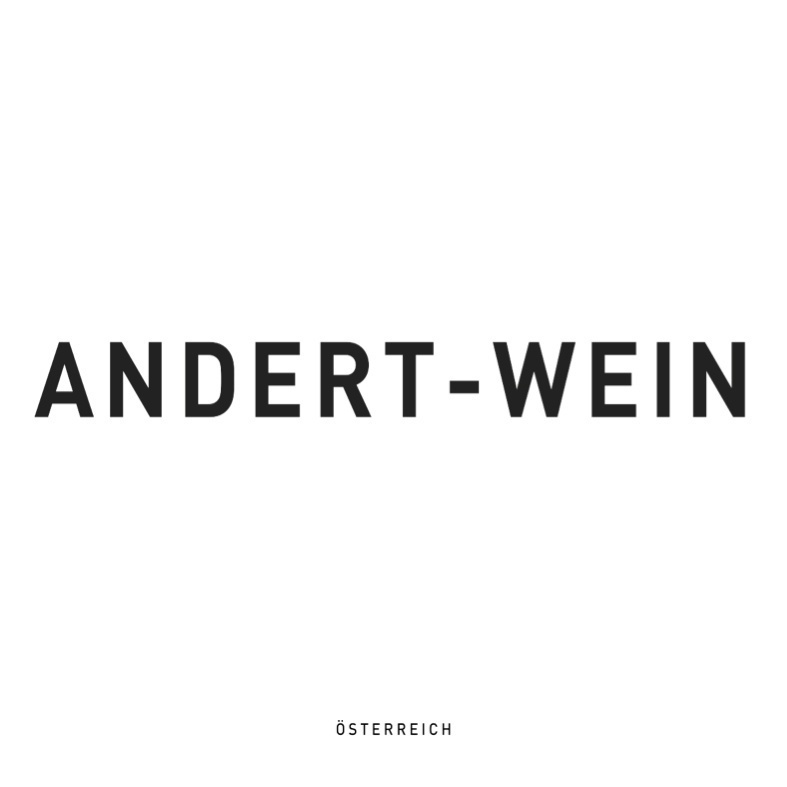
White Wine , Organic
Welschriesling; Pinot Gris; Grüner Veltliner; Chardonnay; Frühroter Veltliner;
10%
2.7 g/l
7.2 g/l
Welschriesling; Pinot Gris; Grüner Veltliner; Chardonnay; Frühroter Veltliner;
10%
2.7 g/l
7.2 g/l
The spelling here is partly due to the local dialect, but also because this is not a typical “Gemischter Satz” in the Viennese sense. The blend of Olaszrizling, Grauburgunder, Grüner Veltliner, Chardonnay, Frühroter Veltliner (Roter Veltliner x Silvaner), and Gelber Muskateller spends 4 days on the skins in open vats. It’s not worked over too hard and punchdowns are more to keep the cap wet than going for heavy extraction. The mixed vineyard was planted in 1974 is only .2 hectares. According to Erich Andert, “If we have a big Andert family party we drink 10 Percent of it.” The last vintage didn’t really have any Gelber Muskateller, so the 2020 is mor aromatic and nothing was destemmed before maceration. Super bright vintage. We are lucky to get a meaningful albeit small amount of this wine. 900 bottles produced.

White Wine , Organic
Welschriesling; Pinot Gris; Grüner Veltliner; Chardonnay; Frühroter Veltliner;
11.1%
1 g/l
6.3 g/l
Welschriesling; Pinot Gris; Grüner Veltliner; Chardonnay; Frühroter Veltliner;
11.1%
1 g/l
6.3 g/l
The spelling here is partly due to the local dialect, but also because this is not a typical “Gemischter Satz” in the Viennese sense. The blend of Olaszrizling, Grauburgunder, Grüner Veltliner, Chardonnay, Frühroter Veltliner (Roter Veltliner x Silvaner), and Gelber Muskateller spends 4 days on the skins in open vats. It’s not worked over too hard and punchdowns are more to keep the cap wet than going for heavy extraction. The mixed vineyard was planted in 1974 is only .2 hectares. According to Erich Andert, “If we have a big Andert family party we drink 10 Percent of it.” Super bright vintage. We are lucky to get a meaningful albeit small amount of this wine.

Red Wine , Organic
Zweigelt; St. Laurent; Cabernet Sauvignon;
12%
1 g/l
6.4 g/l
Zweigelt; St. Laurent; Cabernet Sauvignon;
12%
1 g/l
6.4 g/l
Half destemmed and half whole bunches, it was then open vat fermented, 10 days skin contact, zero racking, and then aged three years in oak before bottling in February 2020. Zero additions and just topped up during élevage. They’ve been making this blend since 1999, but as their farming has become better and better, this wine is proof of the positive effects. Despite the Cabernet Sauvignon, this blend has a ton of energy packed into less than 12% alcohol and ages remarkably well.
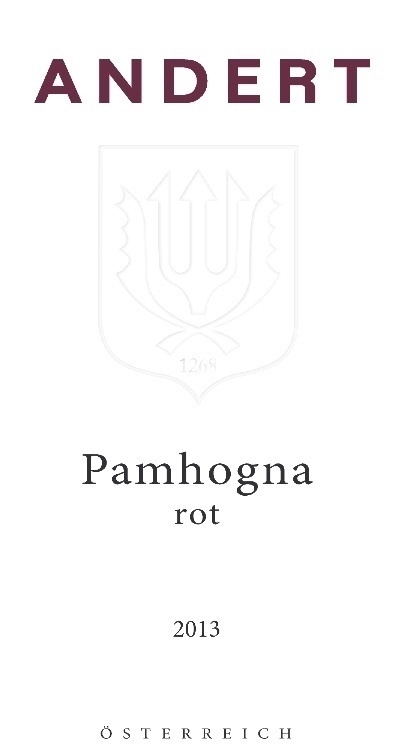
Red Wine , Organic
Zweigelt; St. Laurent; Cabernet Sauvignon;
12%
1 g/l
6.3 g/l
Zweigelt; St. Laurent; Cabernet Sauvignon;
12%
1 g/l
6.3 g/l
Half destemmed and half whole bunches, it was then open vat fermented, 10 days skin contact, zero racking, and then aged three years in oak before bottling in February 2020. Zero additions and just topped up during élevage. They’ve been making this blend since 1999, but as their farming has become better and better, this wine is proof of the positive effects. Despite the Cabernet Sauvignon, this blend has a ton of energy packed into less than 12% alcohol and ages remarkably well.

White Wine , Organic
Pinot Gris; Neuburger; Welschriesling; Pinot Blanc; Chardonnay;
11.6%
6.2 g/l
Pinot Gris; Neuburger; Welschriesling; Pinot Blanc; Chardonnay;
11.6%
6.2 g/l
The biggest change for this vintage is a new press house that isn’t equipped with a destemmer. Everything was whole cluster and foot tread across the board. While still around 5-8 days on the skins, everything was moved by hand in 10L buckets to the press. What resulted was super fast fermentations and low temperatures. Erich said at times you could stick your hand beneath the cap and it was almost cold yet still fermenting away. This is a super fresh, low alcohol and yet super energetic version of the Weiss.

White Wine , Organic
Chardonnay; Welschriesling; Petit Marseng;
12.5%
1 g/l
6.7 g/l
Chardonnay; Welschriesling; Petit Marseng;
12.5%
1 g/l
6.7 g/l
The biggest change for this vintage is a new press house that isn’t equipped with a destemmer or a roof. They are aiming for at least a roof for the 2023 harvest. Everything was hand picked whole cluster and foot tread across the board. While still around 5-8 days on the skins, everything was moved by hand in 10L buckets to the press. What resulted was super fast fermentations at low temperatures. Erich said at times you could stick your hand beneath the cap and it was almost cold yet still fermenting away. This is a super fresh, low alcohol and yet super energetic version of the Weiss. Bottled unfined and unfiltered with 10ppm SO2.

Red Wine , Organic
Zweigelt; Pinot Gris; Pinot Noir;
11.8%
1.1 g/l
7.7 g/l
Zweigelt; Pinot Gris; Pinot Noir;
11.8%
1.1 g/l
7.7 g/l
2016 was a disaster of a vintage – near total destruction from frost. They ended up circling back for a second harvest pass which amounted to around 10% of what they’d normally get. With enough Pinot Gris for half a barrel, they added some purchased Pinot Noir and then topped it up with Zweigelt. They kept the barrel humming until Michael’s 50th Birthday party in August where they served it chilled to everyone. It was a huge success and a happy mistake. They’ve since recreated this in 2018, 2019 and 2020 which is why this one is called #4. It’s a non-vintage blend, some co-fermented, red and white grapes, and a delicious reminder to make the best out of every situation. “Personalgetränk” translates to “staff drink,” which is what always hits the spot after a long day at work.
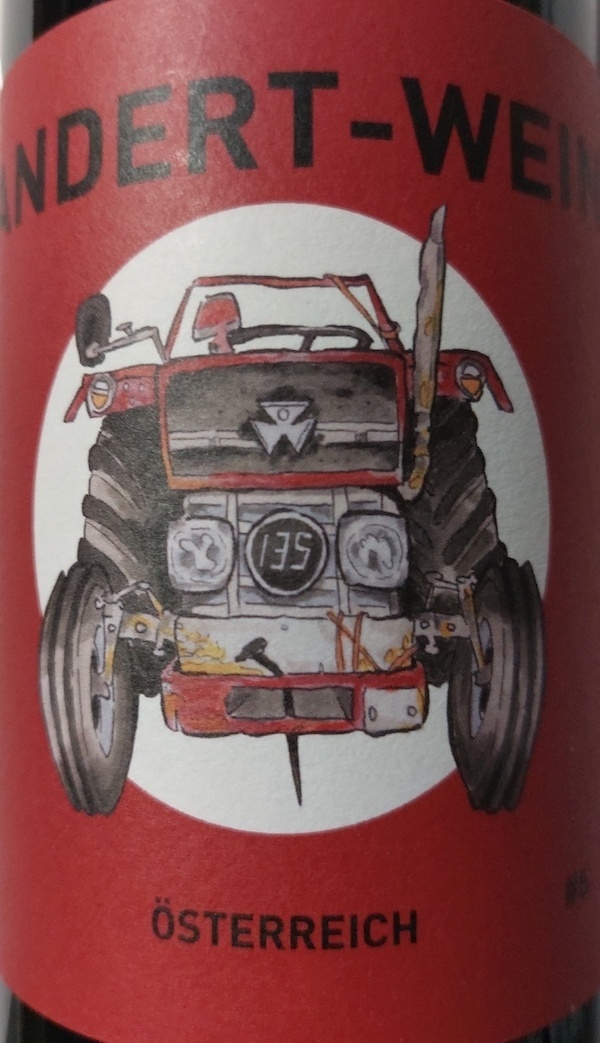
Red Wine , Organic
Zweigelt; Pinot Gris; Pinot Noir;
11.4%
1 g/l
6.9 g/l
Zweigelt; Pinot Gris; Pinot Noir;
11.4%
1 g/l
6.9 g/l
2016 was a disaster of a vintage – near total destruction from frost. They ended up circling back for a second harvest pass which amounted to around 10% of what they’d normally get. With enough Pinot Gris for half a barrel, they added some purchased Pinot Noir and then topped it up with Zweigelt. They kept the barrel humming until Michael’s 50th Birthday party in August where they served it chilled to everyone. It was a huge success and a happy mistake. They’ve since recreated this in 2018, 2019, 2020, 2021, and 2022 which is why this one is called #5. It’s a non-vintage blend, some co-fermented, red and white grapes, and a delicious reminder to make the best out of every situation. This current bottling is mostly ‘20-‘23 fruit. “Personalgetränk” translates to “staff drink,” which is what always hits the spot after a long day at work. The label was designed by a former employee named Dominic Sylvestre. Holds up really well over many days and carries all of the brightness intensity inherent in all Andert wines.
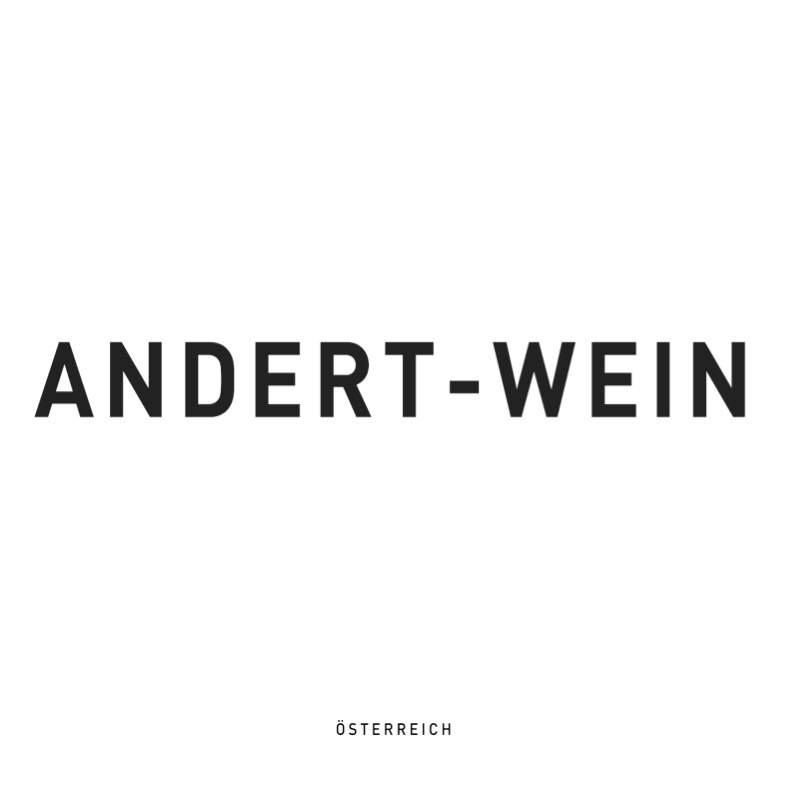
White Wine , Organic
Pinot Gris;
10.5%
2.6 g/l
9 g/l
Pinot Gris;
10.5%
2.6 g/l
9 g/l
This is something we first tried years ago as a visit only treat. Never thought we'd ever get our hands on it. Rülander is what their grandfather preferred to call the grape instead of Grauburgunder or Pinot Gris. The story is that a man named Mr. Rüland arrived from Germany hundreds of years ago and introduced the grape to the region. Erich and Michael have been making this skin macerated version since 2006. Hand picked, 5 days of maceration followed by 9 months in barrel. Bottled unfiltered and with zero additions of any kind. Due to their farming there’s plenty of ripeness, but the alcohol and acidity (9 g/l!) bring remarkable balance. This is a completely different animal than the Ramatos from Italy/Slovenia or the more volcanic skin versions coming from the Mátra. This is also usually bottled after flowering, but Michael had an injury and bottling had to be pushed to late June. The wine got a little wild in barrel and Erich referred to it as “L'enfant terrible.” It has since calmed down in bottle thanks in part to our broken supply chain.

White Wine , Organic
Pinot Gris;
13%
1 g/l
6.2 g/l
Pinot Gris;
13%
1 g/l
6.2 g/l
This is something we first tried years ago as a visit only treat. Never thought we'd ever get our hands on it. Rülander is what their grandfather preferred to call the grape instead of Grauburgunder or Pinot Gris. The story is that a man named Mr. Rüland arrived from Germany hundreds of years ago and introduced the grape to the region. Erich and Michael have been making this skin macerated version since 2006. Hand picked, 5 days of maceration followed by 9 months in barrel. Bottled unfiltered and with zero additions of any kind. Due to their farming there’s plenty of ripeness, but the alcohol and acidity (9 g/l!) bring remarkable balance. This is a completely different animal than the Ramatos from Italy/Slovenia or the more volcanic skin versions coming from the Mátra.

Red Wine , Organic
St. Laurent;
11.8%
1.1 g/l
7.3 g/l
St. Laurent;
11.8%
1.1 g/l
7.3 g/l
This is something that Erich and Michael have made perhaps 6-7 times in the past 15 years. It’s notoriously difficult to grow and laborious in the cellar as well. Most of the time it’s blended away or bottled in super small quantities for private buyers and single restaurants. It was never really considered viable for export. The 2017 had intense (even for white wine) acidity and ended up spending 3 years in barrel in order to come together. People often refer to Sankt Laurent as the savage sibling of Pinot Noir, but that doesn’t really apply here. At first this almost feels like a red white co-ferment in terms of weight and brightness, but then has the texture and ripeness of a red with the benefit of five years of age. In other words, this isn’t in the trying to be Pinot Noir category.